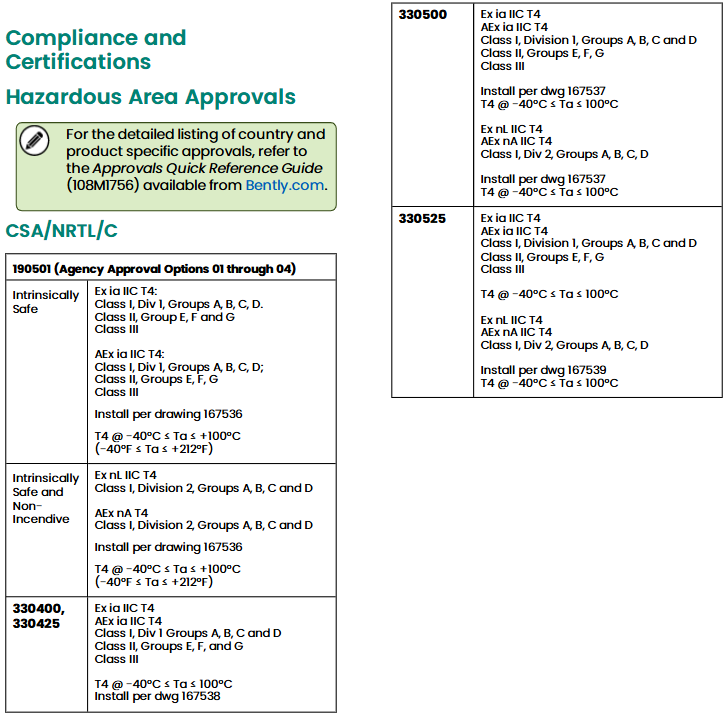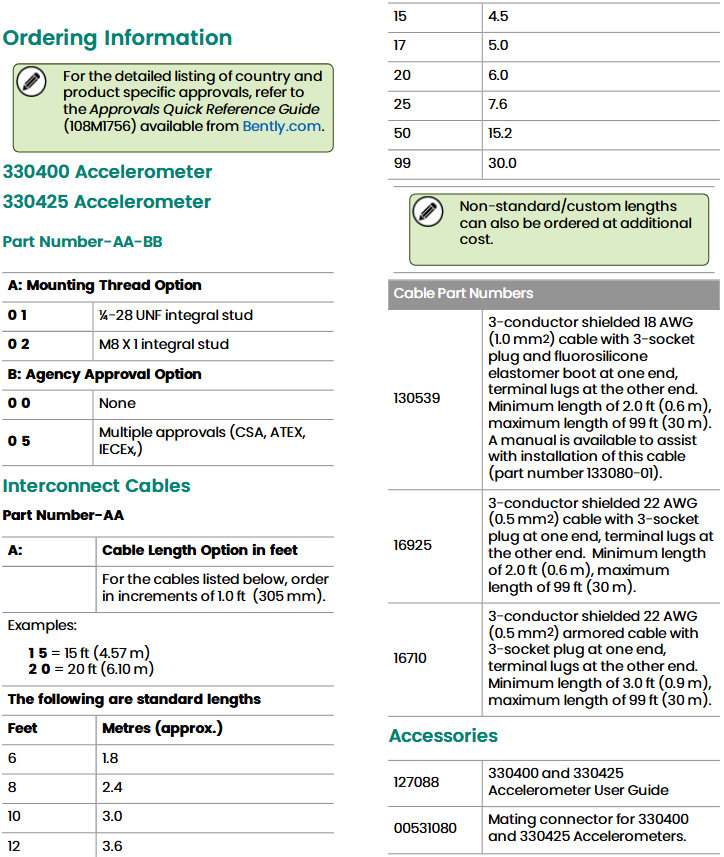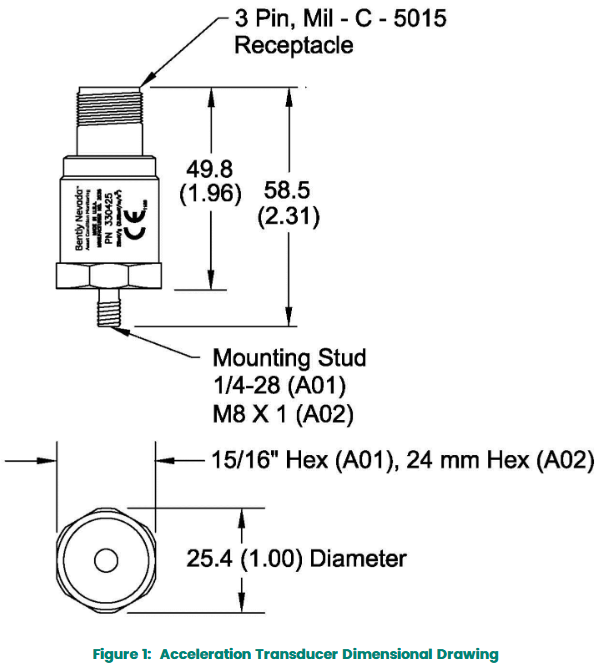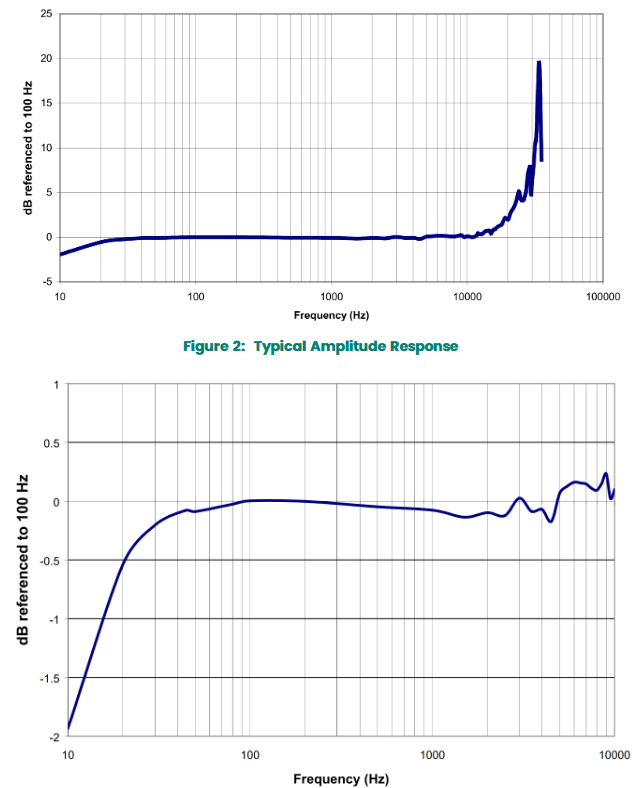

K-WANG


Bently 330400 and 330425 acceleration sensors
330400: Range of 50 g peak, sensitivity of 100 mV/g, suitable for monitoring moderate vibration intensity.
330425: Larger range (75 g peak), sensitivity of 25 mV/g, suitable for high vibration intensity scenarios.
Bently 330400 and 330425 acceleration sensors
Product Overview
1. Core purpose and design objectives
The 330400 and 330425 acceleration sensors are designed specifically for measuring the acceleration of critical machinery casings, especially suitable for scenarios such as gear meshing monitoring. Both comply with the American Petroleum Institute API 670 standard, with the main differences being range and sensitivity:
330400: Range of 50 g peak, sensitivity of 100 mV/g, suitable for monitoring moderate vibration intensity.
330425: Larger range (75 g peak), sensitivity of 25 mV/g, suitable for high vibration intensity scenarios.
2. Application precautions
The sensor needs to be installed on the bearing seat or casing to ensure that the rotor vibration can be effectively transmitted to the installation position, otherwise it may cause measurement signal attenuation or distortion.
Improper installation can affect amplitude and frequency response. It is recommended to refer to the accompanying manual and application guide, and if necessary, apply for Bently Nevada's engineering services to determine the best installation solution.

Detailed explanation of technical specifications
Electrical performance parameters
Parameters: 330400 detailed specifications/330425 detailed specifications
Sensitivity: 10.2 mV/m/s ² (100 mV/g), with an error of ± 5%, calibrated at 20-30 ° C and 100Hz/2.5 mV/m/s ² (25 mV/g), with an error of ± 5%, under the same calibration conditions
Acceleration range: 490 m/s ² (50 g) peak, only valid within the frequency range of 10 Hz-15 kHz; A frequency above 15 kHz (especially the resonance point) will significantly reduce the range/735 m/s ² (75 g) peak, and the range limit is consistent with 330400
Amplitude linearity: ± 1% (when acceleration ≤ 490 m/s ² peak)/± 1% (when acceleration ≤ 735 m/s ² peak)
Broadband noise base: 0.039 m/s ² (0.004 g) rms, frequency range 10 Hz-15 kHz/unspecified, performance consistent with 330400 within the same frequency band
Frequency response: -10 Hz-15 kHz: ± 3 dB/-30 Hz-10 kHz: ± 10%
(Ensure accurate capture of vibration signals within a wide frequency range)/Completely consistent with 330400
Temperature sensitivity: typical value -11% to+3% (the rate of change of sensitivity with temperature within the operating temperature range)/completely consistent with 330400
Lateral sensitivity:<5% (relative to axial sensitivity, reducing the impact of installation angle errors on measurement)/completely consistent with 330400
Installation resonance frequency:>30 kHz (to avoid interference from resonance on high-frequency vibration measurement)/completely consistent with 330400
Power requirements: - Input voltage: -24 ± 0.5 Vdc
-Bias current: 2 mA (nominal)/exactly consistent with 330400
Output bias voltage: -8.5 ± 0.5 Vdc (reference voltage relative to ground)/completely consistent with 330400
Grounding design: shell isolation (to avoid interference with measurement signals caused by grounding loops)/completely consistent with 330400
Maximum cable length: 305 meters (1000 feet), with no signal attenuation when using the specified cable, identical to 330400.

Environmental adaptability parameters
1、 Temperature range
Working and storage temperature
Range: -55 ° C to+121 ° C (-67 ° F to+250 ° F)
Explanation: The sensor can work stably in extreme high and low temperature environments, suitable for high temperature equipment such as industrial furnaces and steam turbines, or cold outdoor scenes. It can also withstand this temperature range during storage without the need for additional temperature control protection.
2、 Impact bearing capacity
Impact limit
Peak value: 49050 m/s ² (5000 g)
Description: It can withstand severe mechanical impacts (such as accidental collisions during installation, instantaneous impacts during equipment start-up/shutdown), ensure that internal components are not damaged, and is suitable for heavy industrial environments with severe vibrations (such as mining machinery and stamping equipment).

3、 Humidity and protective performance
relative humidity
Tolerance range: 100% condensation (non submerged state)
Protection design: The sensor housing is sealed tightly and made of 316L stainless steel material, which can prevent water vapor and dust from entering the internal circuit. It is suitable for humid workshops, outdoor rainy and snowy environments, or high humidity process flows (such as papermaking and food processing).
IP rating
Equivalent protection: IP68 (dustproof and waterproof)
Note: This level is only applicable to the sensor body, and the cable part needs to be separately protected to avoid water ingress or wear.
4、 Magnetic field anti-interference ability
Magnetic field sensitivity
Limit value:<2.21 mm/s ²/Gauss (225 mg/Gauss), test conditions are 50 Gauss, 50-60Hz magnetic field
Explanation: In strong electromagnetic environments (such as near motors and transformers), it is less affected by magnetic field interference, ensuring the accuracy of vibration measurement data and reducing false signals.
5、 Base strain sensitivity
Regarding the differences in different serial numbers
The serial number starts with "G" (produced after April 2004): 49 mm/s ²/mstrain (0.005 g/mtrain), and the influence of substrate strain on measurement is minimal, so there is no need to install an additional base.
Serial number without "G" (produced before April 2004):
When there is no installation base: 980 mm/s ²/mstrain (0.100 g/mtrain), with high strain sensitivity, it needs to be used in conjunction with a dedicated installation base.
When equipped with a mounting base: 4.9 mm/s ²/mstrain (0.0005 g/mtrain), it can effectively reduce substrate strain interference.

- YOKOGAWA
- Energy Access
- Renewable Integration
- Energy Subsidies
- Energy and Water
- Net zero emission
- Energy Security
- Critical Minerals
- A-B
- petroleum
- Mine scale
- Energy and Gender
- Covid-19
- man-machine
- Reliance
- ADVANCED
- SEW
- ProSoft
- WATLOW
- Kongsberg
- FANUC
- VSD
- DCS
- PLC
- Sewage treatment
- cement
- Yaskawa
- Woodward
- BOSCH Rexroth
- MOOG
- General Electric
- American NI
- Rolls-Royce
- CTI
- Honeywell
- EMERSON
- Automobile market
- xYCOM
- Motorola
- architecture
- Industrial information
- New energy
- electricity
- Construction site
- HIMA
- ABB
- Rockwell
- Schneider Modicon
- Siemens
- MAN
- GE
- TRICONEX
- Control Wave
- ALSTOM
- AMAT
- STUDER
- KONGSBERG
- MOTOROLA
- DANAHER MOTION
- Bentley
- Galil
- EATON
- MOLEX
- Triconex
- DEIF
- B&W
- ZYGO
- Aerotech
- DANFOSS
- KOLLMORGEN
- Beijer
- Endress+Hauser
- schneider
- Foxboro
- KB
- REXROTH
- YAMAHA
- Johnson
- Westinghouse
- WAGO
- TOSHIBA
- TEKTRONIX
- BENDER
- BMCM
- SMC
-
GE Hydran M2-X Enhanced Monitoring
-
ABB REG316 1mrk000809-GA Numerical Generator Protection
-
ABB RED670 1MRK004810 Line differential protection
-
GE SR750-P5-G5-S5-HI-A20-R-E Feeder protection system
-
ABB PFTL301E-1.0KN 3BSE019050R1000 PillowBlock Load cells
-
Kollmorgen S33GNNA-RNNM-00 - Brushless Servo Motor
-
Kollmorgen 6sm56-s3000-g-s3-1325 - Servo Motor
-
Kollmorgen AKM52K-CCCN2-00 - Servo Motor
-
Kollmorgen PSR3-230/75-21-202 - Power Supply
-
Kollmorgen akm24d-anc2r-00 - Servo Motor
-
Kollmorgen AKM22E-ANCNR-00 - Servo Motor
-
Kollmorgen S60300-550 - Servo Drive
-
Kollmorgen B-204-B-21 - Servomotor
-
Kollmorgen AKM21E-BNBN1-00 - Servo Motor
-
Kollmorgen TT2953-1010-B - DC Servo Motor
-
Kollmorgen pa8500 - Servo Power Supply
-
Kollmorgen BDS4A-210J-0001-207C2 - Servo Drive
-
Kollmorgen TTRB1-4234-3064-AA - DC Servo Motor
-
Kollmorgen MH-827-A-43 - Servo Motor
-
Kollmorgen AKM24D-ACBNR-OO - Servo Motor
-
Kollmorgen 00-01207-002 - Servo Disk DC Motor
-
Kollmorgen AKM21C-ANBNAB-00 - Servo Motor
-
Kollmorgen PSR3-208/50-01-003 - Power Supply
-
Kollmorgen 6SM56-S3000 - Servo Motor
-
Kollmorgen DBL3H00130-B3M-000-S40 - Servo Motor
-
Kollmorgen 6SN37L-4000 - Servo Motor
-
Kollmorgen AKM65K-ACCNR-00 - Servo motor
-
Kollmorgen 6SM56-L3000-G - Servo Motor
-
Kollmorgen AKMH43H-CCCNRE5K - Servo Motor
-
Kollmorgen PSR4/52858300 - Power Supply
-
Kollmorgen KBM-79H03-E03 - Direct Drive Rotary Motor
-
Kollmorgen AKM33E-ANCNDA00 - Servo Motor
-
Kollmorgen U9M4/9FA4T/M23 - ServoDisc DC Motor
-
Kollmorgen AKM13C-ANCNR-00 - Servo Motor
-
Kollmorgen AKM43L-ACD2CA00 - Servo Motor
-
Kollmorgen AKM54K-CCCN2-00 - Servo Motor
-
Kollmorgen M-605-B-B1-B3 - Servo Motor
-
Kollmorgen AKD-P00606-NBAN-0000 - Rotary Drive
-
Kollmorgen 6SM-37M-6.000 - Servo Motor
-
Kollmorgen A.F.031.5 - Sercos Interface Board
-
Kollmorgen 918974 5054 - Servo PWM
-
Kollmorgen U12M4 - ServoDisc DC Motor
-
Kollmorgen AKD-B00606-NBAN-0000 - Servo Drive
-
Kollmorgen MV65WKS-CE310/22PB - Servo Drive
-
Kollmorgen 65WKS-CE310/22PB - Servo Drive
-
Kollmorgen EM10-27 - Module
-
Kollmorgen S64001 - Servo Drive
-
Kollmorgen CR03200-000000 - Servo Drive
-
Kollmorgen 6SM57M-3000+G - Servo Motor
-
Kollmorgen BDS4 - Servo Drive
-
Kollmorgen AKD-P00306-NBEC-000 - Servo Drive
-
Kollmorgen AKD-B01206-NBAN-0000 - Servo Drive
-
Kollmorgen STP-57D301 - Stepper Motor
-
Kollmorgen 6SM37L-4.000 - Servo Motor
-
Kollmorgen 44-10193-001 - Circuit Board
-
Kollmorgen PRDR9SP24SHA-12 - Board
-
Kollmorgen PRD-AMPE25EA-00 - Servo Drive
-
Kollmorgen DBL3N00130-0R2-000-S40 - Servo Motor
-
Kollmorgen S406BA-SE - Servo Drive
-
Kollmorgen AKD-P00607-NBEI-0000 - Servo Drive
-
Kollmorgen AKD-P01207-NBEC-0000 - Servo Drive
-
Kollmorgen CR03550 - Servo Drive
-
Kollmorgen VSA24-0012/1804J-20-042E - Servo Drive
-
Kollmorgen N2-AKM23D-B2C-10L-5B-4-MF1-FT1E-C0 - Actuator
-
Kollmorgen 04S-M60/12-PB - Servo Drive
-
Kollmorgen H33NLHP-LNW-NS50 - Stepper Motor
-
Kollmorgen A-78771 - Interlock Board
-
Kollmorgen AKM43E-SSSSS-06 - Servo Motor
-
Kollmorgen AKD-P00607-NBEC-0000 - Servo Drive
-
Kollmorgen E21NCHT-LNN-NS-00 - Stepper Motor
-
Kollmorgen cr10704 - Servo Drive
-
Kollmorgen d101a-93-1215-001 - Motor
-
Kollmorgen BDS4A-203J-0001-EB202B21P - Servo Drive
-
Kollmorgen MCSS23-6432-002 - Connector
-
Kollmorgen AKD-P01207-NACC-D065 - Servo Drive
-
Kollmorgen CK-S200-IP-AC-TB - I/O Adapter and Connector
-
Kollmorgen CR10260 - Servo Drive
-
Kollmorgen EC3-AKM42G-C2R-70-04A-200-MP2-FC2-C0 - Actuator
-
Kollmorgen BDS5A-206-01010-205B2-030 - Servo Drive
-
Kollmorgen s2350-vts - Servo Drive
-
Kollmorgen AKM24D-ANC2DB-00 - Servo Motor
-
Kollmorgen E31NCHT-LNN-NS-01 - Stepper Motor
-
Kollmorgen PRD-0051AMPF-Y0 - Servo Board
-
Kollmorgen TB03500 - Module
-
Kollmorgen 60WKS-M240/06-PB - Servo Drive
-
Kollmorgen M21NRXC-LNN-NS-00 - Stepper Motor
-
Kollmorgen H-344H-0212 - Servo Motor
-
Kollmorgen MCSS08-3232-001 - Connector
-
Kollmorgen AKM33H-ANCNC-00 - Servo Motor
-
Kollmorgen PA-2800 - Power Supply
-
Kollmorgen MTC308C1-R1C1 - Servo Motor
-
Kollmorgen PRDR0091300Z-00 - Capacitor Board
-
Kollmorgen BDS4A-206J-0024/01502D79 - Servo Drive
-
Kollmorgen S20330-VTS - Servo Drive
-
Kollmorgen S20250-CNS - Servo Drive
-
Kollmorgen SBD2-20-1105-WO - Servo Drive Board
-
Kollmorgen M405-C-A1--E1 - Servo Motor
-
Kollmorgen PRD-PB805EDD-00 - Servo Drive
-
Kollmorgen 6SM57S-3.000-J-09-HA-IN - Servo Motor
-
Kollmorgen AKM33H-ANCNDA-00 - Servo Motor
-
Kollmorgen PCB-00030200-04 - PCB
-
Kollmorgen H22SSLB-LNN-NS-02 - Stepper Motor
-
Kollmorgen BJRL-20012-110001 - Module
-
Kollmorgen BDS4A-206J-0001404A - Servo Drive
-
Kollmorgen H-342-H-0802 - Servo Motor
-
Kollmorgen CR10561 - Servo Drive
-
Kollmorgen BDS5A-206-00010-205B2-030 - Servo Drive
-
Kollmorgen BDS5A-206-00010-207B-2-030 - Servo Drive
-
Kollmorgen mcss08-3224-001 - Connector
-
Kollmorgen M-207-B-23-B3 - Servo Motor
-
Kollmorgen PRD-0041200Z-S0 - Encoder/Resolver Card
-
Kollmorgen MH-225-G-61 - Motor
-
Kollmorgen MT308B1-T1C1 - Servo Motor
-
Kollmorgen BDS4A-240J-0001604C83 - Servo Drive
-
Kollmorgen 6SM57-S-3000 - Servo Motor
-
Kollmorgen N-T31V-15-5B-6-MF3-FT1E-C251 - Actuator
-
Kollmorgen PRD-0051AMPA-X0 - Servo Board
-
Kollmorgen CF-SS-RHGE-09 - Cable
-
Kollmorgen DIGIFAS7204 - Servo Drive
-
Kollmorgen S30101-NA - Servo Drive
-
Kollmorgen DIGIFAS7201 - Servo Drive
-
Kollmorgen PRD-0051AMPA-Y0 - Servo Board
-
Kollmorgen AKM23D-EFCNC-00 - Servo Motor
-
Kollmorgen SE10000 - Servo Drive
-
Kollmorgen PSR4/5A-112-0400 - Power Supply
-
Kollmorgen AKM31H-ANCNC-01 - Servo Motor
-
Kollmorgen M-203-B-93-027 - Servo Motor
-
Kollmorgen CP-SS-G1HE-05 - Connector




